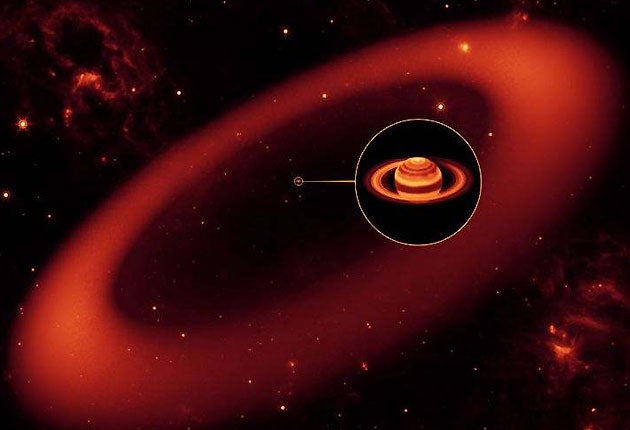Nasa discovers huge ring of ice orbiting Saturn

A giant ring so faint it is all but invisible to conventional light telescopes has been discovered around Saturn by the infra-red imaging instruments on board Nasa's Spitzer space telescope.
The ring extends much further out than Saturn's other rings, and is tilted at a different angle to the rest in relation to the planet's axis of rotation.
Saturn's rings are known to be composed of dust, ice and other debris caught up in orbit around the planet. Scientists believe the newly discovered ring is so tenuous because its particles of ice and dust are thinly dispersed in space. This means they do not reflect much light, making the ring hard to see.
Spitzer's infra-red camera was able to detect the "glow" of the band's cool dust, which only manages to reach a temperature of minus 193C. Even at such low temperatures, the dust gives off enough infra-red light to be picked up by Spitzer, the $800m space observatory launched in 2003. "By focusing on the glow of the ring's cool dust, Spitzer made it easy to find," said Anne Verbiscer, an astronomer at the University of Virginia. "[But] the particles are so far apart that if you were to stand in the ring, you wouldn't even know it. This is one supersized ring. If you could see [it], it would span the width of two full-moons' worth of sky, one on either side of Saturn."
Saturn's moon Phoebe is almost certainly generating the dust and ice grains that makes up the ring, which extends from between 3.7 million and 12 million miles from Saturn and is inclined at an angle of 27 degrees to the main ring system.
The discovery, to be published in the journal Nature, may also explain why another of Saturn's moons, Iapetus, has both light and dark hemispheres.
The ring is depositing debris on Iapetus in a pattern that makes one half of it look darker than the other because the moon orbits Saturn in the opposite direction to Phoebe and its associated ring, astronomers say.
Join our commenting forum
Join thought-provoking conversations, follow other Independent readers and see their replies
Comments